Drought Tolerant Plants for San Diego Landscapes: A Complete Guide
Welcome to the ultimate guide to drought-tolerant plants for San Diego landscapes! As water becomes increasingly scarce and valuable, the smart choice for any garden enthusiast or homeowner is to turn towards landscaping solutions that are not just beautiful but also water-wise. San Diego, with its coastal desert climate, is the perfect place to embrace drought-tolerant plants. Whether you’re looking to revamp your garden, introduce native beauty, or simply reduce your water bill, this guide has got you covered.
Embracing the Drought: Why Go Drought-Tolerant?
Before we dive into the green goodness of drought-tolerant plants, let’s talk about why they’re so crucial for San Diego landscapes. The region has faced significant drought challenges, marking the need for sustainable landscaping practices. Drought-tolerant plants require minimal water once established, making them perfect for the climate. Plus, they bring a slice of native beauty to your garden, attract local wildlife, and contribute to the ecological balance.
Native Beauties and Beyond: Plants for Every San Diego Garden
San Diego’s native plants are naturally drought-resistant, thriving in the region’s unique climate without much fuss. However, the variety doesn’t stop there. Here’s a mix of native wonders and global troopers that’ll make your garden both stunning and sustainable:
1. Shoestring Acacia (Acacia stenophylla)
This Australian native is a fast-growing tree that can reach heights of 20-40 feet. Its weeping habit and long, narrow leaves give it a graceful appearance, perfect for adding movement and texture. It’s extremely drought-tolerant once established and thrives in full sun, providing lovely shade and a habitat for birds.
| Feature | Detail |
| Height | 20-40 feet |
| Spread | 15-30 feet |
| USDA | 9-11 |
| Links | More Info |

2. Blue Fescue (Festuca glauca)
A clump-forming ornamental grass that grows about 8-12 inches tall and wide, Blue Fescue sports fine, blue-green foliage that adds a striking contrast to any landscape. It’s perfect for borders, rock gardens, or as a groundcover in full sun areas. This grass is low-maintenance, requiring minimal water once established.
| Feature | Detail |
| Height | 8-12 inches |
| Spread | 10-18 inches |
| USDA | 4-8 |
| Links | More Info |
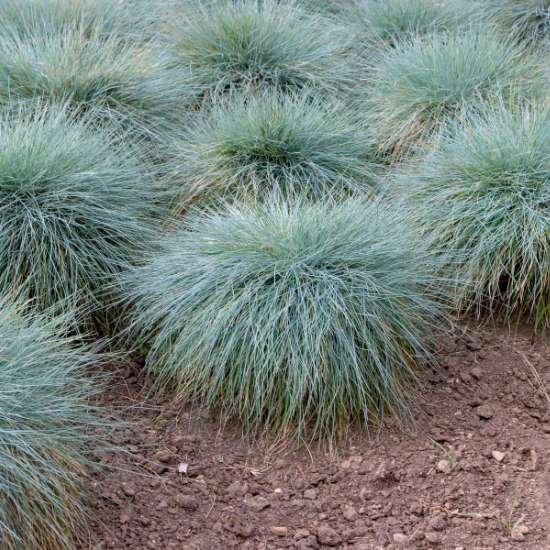
3. Coastal Sage (Salvia leucophylla)
This native sage grows 2-3 feet tall and wide, featuring aromatic, silver-green leaves and producing beautiful purple flowers from late spring to early summer. It’s highly attractive to bees, butterflies, and hummingbirds, enhancing biodiversity in your garden. Coastal Sage is ideal for sunny slopes and mixed borders, offering both beauty and fire resistance.
| Feature | Detail |
| Height | 2-3 feet |
| Spread | 2-4 feet |
| USDA | 8-10 |
| Links | More Info |
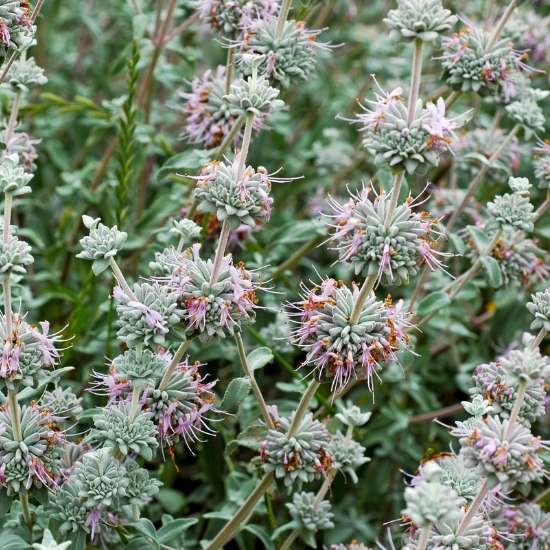
4. California Poppy (Eschscholzia californica)
The state flower of California, this annual or perennial plant brightens landscapes with its cheerful orange flowers from early spring through fall. Growing 6-15 inches tall, it’s perfect for wildflower gardens, borders, or as a vibrant groundcover. California Poppies are self-seeding, ensuring a display of color year after year with minimal effort.
| Feature | Detail |
| Height | 6-15 inches |
| Spread | 6-10 inches |
| USDA | 5-10 |
| Links | More Info |
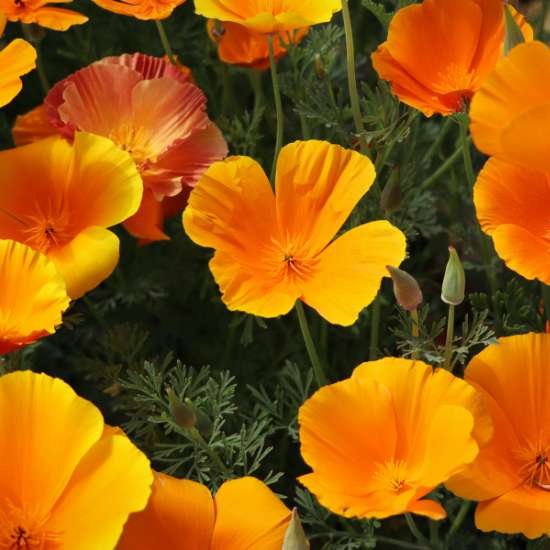
5. Yucca (Yucca spp.)
Yuccas are striking plants with rosettes of spiky leaves, capable of growing from 2 to over 30 feet tall depending on the species. They produce dramatic spikes of white flowers, adding architectural interest. Well-suited to modern or desert-themed landscapes, Yuccas are incredibly resilient, thriving in full sun and requiring little water once established.
| Feature | Detail |
| Height | 2-30 feet (varies by species) |
| Spread | 2-15 feet (varies by species) |
| USDA | 5-11 |
| Links | More Info |
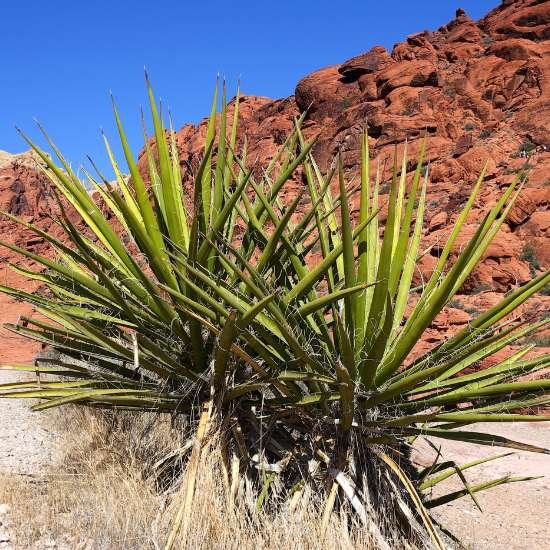
6. Century Plant (Agave americana)
A stunning succulent that can grow up to 6 feet tall and wide, the Century Plant is known for its large, spiky leaves. It blooms once in its lifetime, sending up a tall flower spike before dying. This plant is a statement-maker in any landscape, ideal for adding drama and texture. It prefers full sun and well-drained soil.
| Feature | Detail |
| Height | Up to 6 feet (much taller when flowering) |
| Spread | Up to 8 feet |
| USDA | 8-11 |
| Links | More Info |
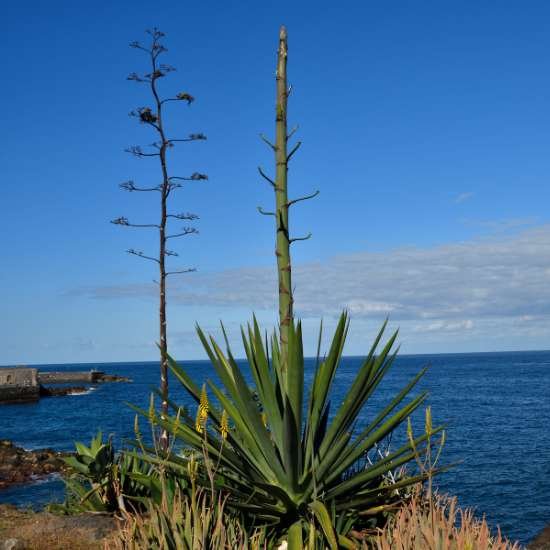
7. Coastal She Oak (Casuarina equisetifolia)
Native to Australia and Southeast Asia, this evergreen tree can grow 30-60 feet tall, offering excellent shade. Its needle-like foliage creates a soft, feathery appearance, and it’s known for its ability to withstand coastal winds, making it an ideal windbreak. Coastal She Oak is highly drought-tolerant and thrives in sandy soils.
| Feature | Detail |
| Height | 30-60 feet |
| Spread | 20-40 feet |
| USDA | 9-11 |
| Links | More Info |

8. Eucalyptus (Eucalyptus spp.)
With over 700 species, Eucalyptus trees offer diversity in size and form. They’re celebrated for their fast growth, distinctive foliage, and aromatic scent. Eucalyptus trees can provide quick shade and privacy, growing well in full sun and adapting to various soil types. Their leaves can be used in floral arrangements or as a natural insect repellent.
| Feature | Detail |
| Height | 25-180 feet (varies by species) |
| Spread | 15-45 feet (varies by species) |
| USDA | 8-11 |
| Links | More Info |

9. Lavender (Lavandula spp.)
This perennial herb is beloved for its fragrant purple flowers and silvery-green foliage. It grows 1-3 feet tall, making it perfect for borders, herb gardens, or as a fragrant addition to walkways. Lavender prefers full sun and well-drained soil, attracting bees and butterflies while repelling deer and rabbits.
| Feature | Detail |
| Height | 1-3 feet |
| Spread | 1-4 feet |
| USDA | 5-9 |
| Links | More Info |

10. Egyptian Starcluster (Pentas lanceolata)
This perennial herb is beloved for its fragrant purple flowers and silvery-green foliage. It grows 1-3 feet tall, making it perfect for borders, herb gardens, or as a fragrant addition to walkways. Lavender prefers full sun and well-drained soil, attracting bees and butterflies while repelling deer and rabbits.
| Feature | Detail |
| Height | 18-36 inches |
| Spread | 18-24 inches |
| USDA | 10-11 (often grown as an annual) |
| Links | More Info |
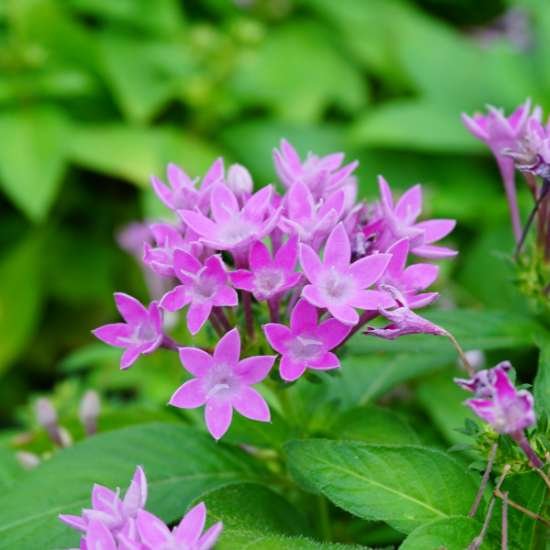
11. California Lilac (
spp.)
Ranging from low-growing ground covers to tall shrubs, California Lilac is prized for its clusters of blue or purple flowers in spring. It’s an excellent choice for attracting pollinators and adding a burst of color to native, drought-tolerant gardens. California Lilac thrives in full sun and well-drained soil, requiring little to no water once established.
| Feature | Detail |
| Height | 1-20 feet (varies by species) |
| Spread | 1-10 feet (varies by species) |
| USDA | 8-10 |
| Links | More Info |

12. Manzanita (Arctostaphylos spp.)
Manzanitas are celebrated for their smooth, mahogany-red bark and twisted branches, offering a striking architectural element to the landscape. Their leathery leaves can range from green to gray-green, and their delicate bell-shaped flowers bloom in winter and early spring, followed by small apple-like fruits. Adapted to California’s varied climate, they require minimal water once established and provide significant habitat value.
| Feature | Detail |
| Height | 1-20 feet, depending on species |
| Spread | 2-15 feet, depending on species |
| USDA | Zones 8-11 |
| Links | More Info |

13. Toyon (Heteromeles arbutifolia)
Also known as California Holly, Toyon is a robust evergreen shrub or small tree that shines in the winter landscape with its clusters of bright red berries and leathery dark green leaves. It’s highly adaptable, drought-tolerant once established, and provides essential food and shelter for wildlife, including birds and butterflies.
| Feature | Detail |
| Height | 8-15 feet, can reach up to 30 feet in ideal conditions |
| Spread | 4-10 feet |
| USDA | Zones 7-11 |
| Links | More Info |

14. Cleveland Sage (Salvia clevelandii)
Cleveland Sage is a fragrant native sage known for its aromatic leaves and stunning displays of lavender to blue flowers that appear in spherical clusters. It’s particularly beloved by gardeners for its ease of care, drought tolerance, and the ability to attract a plethora of pollinators. Thriving in full sun and well-draining soil, it’s a perfect choice for adding color and fragrance to water-wise gardens.
| Feature | Detail |
| Height | 3-5 feet |
| Spread | 3-5 feet |
| USDA | Zones 8-11 |
| Links | More Info |
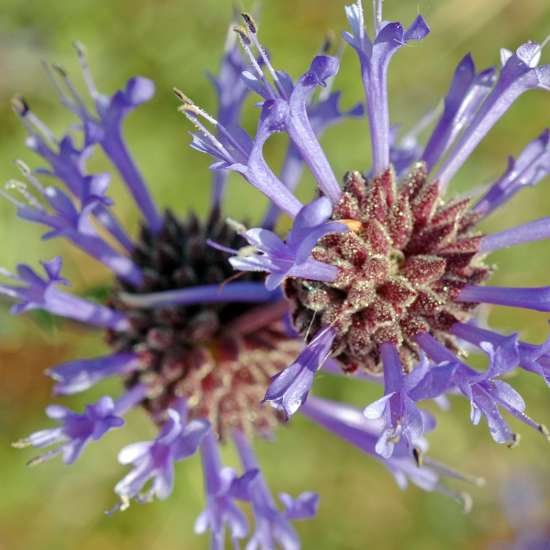
15. Lemonade Berry (Rhus integrifolia)
Lemonade Berry is an evergreen shrub native to the coastal regions of California, known for its dense, rounded form, thick leathery leaves, and clusters of small pink to white flowers that give way to tart, reddish berries. The berries, reminiscent of lemonade when chewed, along with its attractive form, make it a unique addition to native gardens. It’s drought-tolerant, salt-tolerant, and provides habitat and food for local wildlife.
| Feature | Detail |
| Height | 6-10 feet, occasionally taller |
| Spread | 8-15 feet |
| USDA | Zones 9-11 |
| Links | More Info |
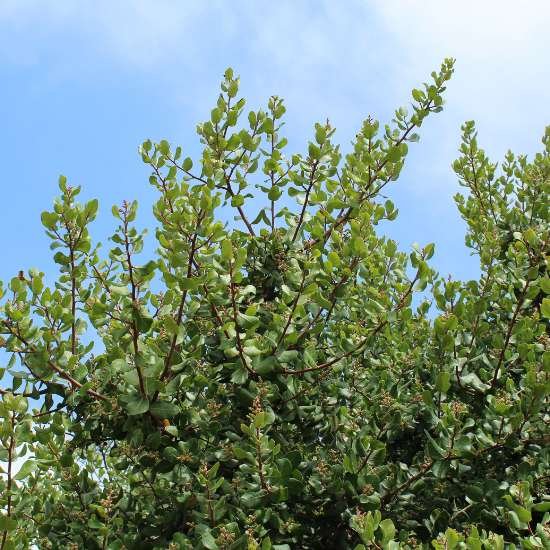
Designing Your Drought-Tolerant Paradise
Creating a drought-tolerant landscape doesn’t mean compromising on beauty or variety. Here are some tips to get you started:
- Sun and Shade: Assess the sun and shade patterns in your garden. Some drought-tolerant plants thrive in full sun, while others prefer partial shade.
- Plant Grouping: Group plants with similar water needs together to optimize your watering routine.
- Mulch Magic: Use mulch around your plants. It helps retain soil moisture, keeps the roots cool, and adds a finished look to your garden beds.
- Irrigation Innovation: Consider installing a drip irrigation system. It delivers water directly to the roots, reducing waste and ensuring your plants get just what they need.
Whether you’re designing a new garden from scratch or integrating drought-tolerant plants into your existing landscape, incorporating these tips can lead to a lush, low-maintenance garden that’s as kind to the environment as it is on the eyes.
- Plant Selection: Embrace diversity by mixing trees, shrubs, grasses, and perennials to create a layered, textured garden. This not only adds depth but also supports a wider range of wildlife.
- Hardy Ground Covers: Replace thirsty lawns with drought-tolerant ground covers like California Lilac or Blue Fescue. They provide a verdant carpet without the high water bill.
- Artful Accents: Consider adding hardscape elements like rocks, gravel paths, or a dry river bed. These can break up the greenery, add interest, and reduce water usage further.
- Container Gardening: Not all drought-tolerant plants need to be in the ground. Many thrive in containers, allowing you to add green touches to patios, balconies, and other hard surfaces.
- Seasonal Splendor: Choose plants that bloom at different times of the year to ensure your garden remains vibrant across seasons. The ever-changing display will keep your outdoor space interesting and inviting.
Care and Maintenance: Keeping Your Garden Thriving
While drought-tolerant plants are low maintenance, they do benefit from some care, especially when they’re getting established. Here are a few tips to ensure your garden thrives, supporting the longevity and beauty of your Backyard Remodeling in San Diego efforts:
- Water Wisely: Even drought-tolerant plants need water to establish. Water deeply but infrequently to encourage deep root growth. Once established, many of these plants will thrive with minimal irrigation, depending on the weather, which is ideal for San Diego Xeriscape .
- Pruning and Deadheading: Regular pruning helps keep plants healthy and encourages new growth. Deadheading spent flowers, especially on perennials like lavender and California poppy, can promote a second bloom.
- Mulching: Refresh mulch around your plants annually to maintain soil moisture and suppress weeds.
- Fertilizing: Most drought-tolerant plants thrive in poor soil and don’t need much fertilizer. However, an occasional light feeding can support blooming and growth, especially for more ornamental or cultivated varieties.
Backyard Remodeling San Diego Pros: Bringing Your Drought-Tolerant Dreams to Life
While this guide is a great starting point, creating the perfect drought-tolerant landscape can be a complex process, blending art, science, and a deep understanding of your local ecosystem. If you’re looking for professional assistance to bring your vision to life, consider reaching out to a landscaping expert. With years of experience in creating beautiful, sustainable gardens in San Diego, a professional landscaper can help you select the right plants, design your space, and implement water-saving irrigation solutions that will ensure your garden is not only gorgeous but truly drought-tolerant.
Final Thoughts
Embracing drought-tolerant plants in your San Diego landscape is more than just a gardening trend; it’s a responsible choice for the environment and a practical solution for your water bill. With the right selection of plants and design strategies, you can create an outdoor space that’s both sustainable and stunning. So, why not start your drought-tolerant garden project today? The benefits are clear, and the beauty is undeniable. Your perfect San Diego garden awaits!

Backyard Remodeling San Diego Pros transforms your outdoor spaces with a personalized touch. Specializing in sustainable and high-quality renovations, we ensure every project meets our clients’ vision. Trust us to make your San Diego backyard dream a reality.
The Best Backyard Contractor in San Diego !